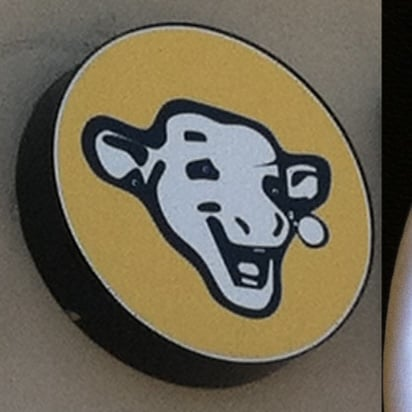Google it? Axiomatic definition, dedekind cuts, cauchy sequences are the 3 typical ones and are provably equivalent.
Kogasa
- 0 Posts
- 812 Comments
I’m fully aware of the definitions. I didn’t say the definition of irrationals was wrong. I said the definition of the reals is wrong. The statement about quantum mechanics is so vague as to be meaningless.
That is not a definition of the real numbers, quantum physics says no such thing, and even if it did the conclusion is wrong

 11·5 days ago
11·5 days agoU good?
Being suitable for human consumption doesn’t mean it’s not also suitable for playing a role in a more efficient food chain
Stokes’ theorem. Almost the same thing as the high school one. It generalizes the fundamental theorem of calculus to arbitrary smooth manifolds. In the case that M is the interval [a, x] and ω is the differential 1-form f(t)dt on M, one has dω = f’(t)dt and ∂M is the oriented tuple {+x, -a}. Integrating f(t)dt over a finite set of oriented points is the same as evaluating at each point and summing, with negatively-oriented points getting a negative sign. Then Stokes’ theorem as written says that f(x) - f(a) = integral from a to x of f’(t) dt.
Going to almost certainly be less than 1. Moving further up the food chain results in energy losses. Those fish are going to use energy for their own body and such
For sure, which is why I said “another food source would be needed.” I had in mind something like the wild-caught fish being processed into something useful as part of a more efficient food chain, e.g. combined with efficiently-farmed plant material.
Moreover there’s high mortality rates inside of fish farms for fish themselves.
I don’t have any context on the other pros and cons of fish farming, so definitely not arguing whether they’re a net positive or not.

 31·5 days ago
31·5 days agoYour first two paragraphs seem to rail against a philosophical conclusion made by the authors by virtue of carrying out the Turing test. Something like “this is evidence of machine consciousness” for example. I don’t really get the impression that any such claim was made, or that more education in epistemology would have changed anything.
In a world where GPT4 exists, the question of whether one person can be fooled by one chatbot in one conversation is long since uninteresting. The question of whether specific models can achieve statistically significant success is maybe a bit more compelling, not because it’s some kind of breakthrough but because it makes a generalized claim.
Re: your edit, Turing explicitly puts forth the imitation game scenario as a practicable proxy for the question of machine intelligence, “can machines think?”. He directly argues that this scenario is indeed a reasonable proxy for that question. His argument, as he admits, is not a strongly held conviction or rigorous argument, but “recitations tending to produce belief,” insofar as they are hard to rebut, or their rebuttals tend to be flawed. The whole paper was to poke at the apparent differences between (a futuristic) machine intelligence and human intelligence. In this way, the Turing test is indeed a measure of intelligence. It’s not to say that a machine passing the test is somehow in possession of a human-like mind or has reached a significant milestone of intelligence.

 4·5 days ago
4·5 days agoI don’t think the methodology is the issue with this one. 500 people can absolutely be a legitimate sample size. Under basic assumptions about the sample being representative and the effect size being sufficiently large you do not need more than a couple hundred participants to make statistically significant observations. 54% being close to 50% doesn’t mean the result is inconclusive. With an ideal sample it means people couldn’t reliably differentiate the human from the bot, which is presumably what the researchers believed is of interest.
What’s the ROI? If 15% of wild caught fish are used to support fish farms that produce twice as much, it’s not as obviously a bad thing. There’d need to be another food source though.
Only if you’re trying to get a numerical point evaluation. For example, one can use Fourier series to represent complex signals in terms of sine waves, and then reproduce the sine waves with hardware to reproduce the original signal. This is how a simple synthesizer produces different kinds of tones.
What you have described is technology beyond the imagination of the men of my time
What century is it

 4·8 days ago
4·8 days agoYou tell em Admiral

 5·9 days ago
5·9 days agoWould not be surprised if it’s getting confused about a wallet sponsorship

 7·9 days ago
7·9 days agoJust wait til you find the 1-1/2" screws
We aren’t trying to establish that neurons are conscious. The thought experiment presupposes that there is a consciousness, something capable of understanding, in the room. But there is no understanding because of the circumstances of the room. This demonstrates that the appearance of understanding cannot confirm the presence of understanding. The thought experiment can’t be formulated without a prior concept of what it means for a human consciousness to understand something, so I’m not sure it makes sense to say a human mind “is a Chinese room.” Anyway, the fact that a human mind can understand anything is established by completely different lines of thought.

 4·9 days ago
4·9 days agoShould be a lot easier for modern parents who can easily use online resources to learn
Shoutout to my fort myers and cape coral homies






Yes, with Iosevka font